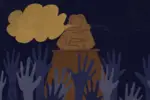For many creative spirits, the development of the idea is the most exciting part. Many writers will design original characters, scribble notes about a world’s dynamics, create a magic system and some even go so far as to create a new language. Even so, the creative process ends here for many new writers. Creative writing, like any other form of art, takes time and effort to learn, and too many are intimidated and turned away from the threatening blank page. After all, no one wants to sound like a new writer. Here are some mistakes to avoid in one’s creative writing journey and some tips for writing like a pro.
Know How To Read Like a Writer
This one may throw some writers off, but it all comes down to a fairly simple principle. It is no secret that reading is necessary for writers. Even Stephen King himself writes that “if you want to be a writer, you must do two things above all others: read a lot and write a lot.” Reading is important for many reasons, and there is a specific method of observation when it comes to examining a text from a writing standpoint. While others read for entertainment or to unpack a text in relation to another field, the reading writer will be engaged — not just in the plot — but also with how the plot is constructed. The writer will pick apart character motives, which descriptors are used for each character. They’ll notice which words or habits are being used to keep characters separated. There are many articles online that discuss tips on how to achieve this goal, but the end result should come back to the writer learning creative writing strategies by shadowing the work of others.
Learn How to Format Dialogue Before Writing Dialogue
Many new writers have trouble figuring out dialogue, especially those students in creative writing classes who may not have thought about it before. This is an understandable problem, as dialogue has some specific formatting rules. Like any other format, it requires a bit of a learning curve — luckily, this learning curve is relatively easy to move past with a bit of practice, and there are resources aplenty to guide one’s journey. Additionally, it is always a great idea to pay attention to the text tags and surrounding sentences when reading for fun. This is a great way to not only become used to formatting dialogue, but also find inspiration through seeing another author’s style.
Writing In the First Person
Gravitating toward first or third person is generally considered a matter of preference — and while there are many great writers who use the first person, there are many challenges that come with doing so. It is well known that new writers often get bogged down with the number of sentences beginning with the subject “I,” followed closely by an action verb. Pairing this with a simple subject-verb-object sentence structure is a surefire way to make creative writing dull and repetitive.
In an article about effective first-person narration, Ruthanne Reid provided the following example to help illustrate first-person filler words: “‘I saw the dog, brown and shaggy.’ You’re watching the character see the dog. ‘The dog was brown and shaggy.’ Now you’re seeing what the character sees, and there is no space between you and the character.” Being mindful of one’s subjects is a great way to write more intentionally and get rid of unwanted “I” sentences.
Another common problem with using the first person is that many writers, especially those who write without the aid of an outline, are easily drawn away from the main plot of one’s story, finding it easier to write a stream of consciousness that is completely unrelated to the point. While writing stream of consciousness might be a fun exercise in creative writing, including it in a novel or short story can be incredibly confusing to the reader if done without purpose.
The Importance of Outlining
In most writing communities, it’s commonly said that there are two types of writers: those who re-write, and those who outline. Technically, there is nothing wrong with re-writing. In fact, re-writing select sections can be crucial to the revision process, but it does tend to take significantly longer than outlining first. Students who are in a creative writing class and working with a deadline should also take note of this strategy, as it can significantly improve one’s ability to write a well-constructed story within a shorter timeframe.
This is not to say that any author who chooses one or the other will be automatically successful, as every person needs to find their own creative writing process. This being the case, working with an outline, at least in the preliminary stages of writing, is a wonderful way for new writers to begin organizing their thoughts — especially when working on longer pieces. The best way to figure out how to outline is to explore different strategies and implement the techniques that fit one’s writing needs and set aside those that don’t.
Learn How To Introduce a Character in a Way That Fits the Work
One major issue that can make any writer seem like a newbie is not being able to write a character description that integrates well into the story. Too often, rough draft copies begin with a stereotypical image of a protagonist that is formatted as follows: the character’s name, age, location and a general description of their clothing or background. While this might be acceptable in high school writing assignments or in fan fiction, most authors need to move away from this style of character description at some point in their development. One article from Writer’s Digest provided 11 tips for writing character descriptions. Among these creative writing “secrets,” one noteworthy tip was that describing “a character’s immediate surroundings can provide the backdrop for the sensory and significant details that shape the description of the character himself.”
Know What the Next Steps Are For a Future in Creative Writing
Anyone who is serious about creative writing will read in their target genre and follow writing blogs. Reading in the current genre ties back to reading like a writer, but more importantly — for those looking to publish — it can provide insight into what themes are selling. Following writing blogs is also essential because plateauing in one’s writing ability is incredibly common. Receiving “how-to” content is a great way to continue growing. The Writer’s Digest is among the most influential resources for writers, as they routinely publish updated material. Additionally, many authors have blogs where they discuss their specific writing process.
Whether writing a short story, personal narrative, fan fiction, creative nonfiction or any other variety of longer work, implementing these tips as a starting point is sure to springboard the creative spirit into the world of creative writing.


















Great insights! Avoiding these common writing mistakes can truly elevate storytelling. At XtraSaaS, I focus on clear, impactful content too—you can check my writing samples under the Rizwan profile. Keep up the great work!
Great tips! Reading like a writer really changes how you experience stories, and learning proper dialogue formatting early on is a game-changer. For anyone looking to grow as a writer or content creator, I also share helpful insights over at TalkSocially.com.
Great tips! Reading like a writer really changes how you experience stories, and learning proper dialogue formatting early on is a game-changer. For anyone looking to grow as a writer or content creator, I also share helpful insights over at TalkSocially.com.
Great tips! Reading like a writer really changes how you experience stories, and learning proper dialogue formatting early on is a game-changer. For anyone looking to grow as a writer or content creator, I also share helpful insights over at TalkSocially.com.
Great tips! Reading like a writer really changes how you experience stories, and learning proper dialogue formatting early on is a game-changer. For anyone looking to grow as a writer or content creator, I also share helpful insights over TalkSocially